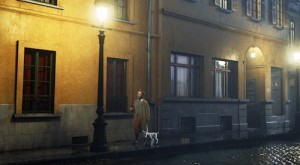3D
Wednesday, January 11th, 2012 • Horrorthon Posts
Continuing my trend of going in the opposite direction from the prevailing Horrorthon opinion, I have totally got the 3D bug.
What happened? Yesterday I saw The Adventures of Tintin (which, unfortunately, I could not see on an IMAX screen without going to Rochester; I missed my shot at the four Manhattan IMAX theaters) in Digital 3D. The movie was beyond glorious in my opinion (and I’m as die-hard a Tintin fan as you’re likely to meet amongst Americans), but, more important, it was the first time I’d had a thoroughly enjoyable (and mind-blowing!) 3D viewing experience.
Actually I haven’t seen that many 3D movies; the only recent ones I can think of are Avatar (ugh) and Beowulf, both of which I saw in IMAX and both of which had me less-than-ideally positioned in the theater. Avatar had jarringly intrusive 3D compositions, with Cameron constantly putting objects in the extreme foreground that get clipped by the margins of the screen, which is a disconcerting effect because the screen edges are coming at you like helicopter blades; it’s like the dimensional warp in Arthur C. Clarke’s 2001 novelization where David Bowman is “looking into” the monolith at the end. (Also, Cameron likes to “stretch” the 3D along the Z-axis by boosting the ocular distance, so that the parallax convergence point is still at the screen surface but everything else appears at an exaggerated depth behind or in front.) Beowulf, on the other hand, used a much more gentle 3D technique, with misty Nordic landscapes moving back into the infinite horizon, but that movie had much cruder modeling and animation than Tintin, and, although Zemeckis did an admirable job of composing with the virtual 3D camera (and inventing both static and moving shots that took advantage of the 3D effects), Zemeckis is no Spielberg.
Before the movie, we were shown the usual string of six or seven trailers, and, to my surprise, they were all in 3D. This is the interesting part: I’d seen the The Hobbit trailer dozens of times, and, when it started in 3D, I was actually kind of underwhelmed. I watched the documentary vlog (which I recommend) in which Peter Jackson explained his Epic-RED-based stereoscopic filming technique, and it’s Peter Jackson, so I was expecting the 3D footage to be spectacular, but there seemed to be something wrong with it; the shots had a sort of “View-Master” aspect, as if a bunch of flat card-like figures had been arranged in a really good New Zealand diorama. (It’s quite possible that my eyes hadn’t yet adjusted to the whole setup.) Then there was a bunch of mediocre-looking DreamWorks animation (that stuff’s just always going to look like crap to me) and Pixar’s Brave, which (after the brilliance of Up and Wall•E) seemed stylistically retrograde.
But what was most interesting were the trailers for the upcoming conversions of Star Wars Episode I and Titanic, both of which looked absolutely incredible—my jaw hit the floor. I didn’t even know that kind of result was even theoretically possible. Everyone sneers so dismissively at post-3D conversion, which corresponds with my primitive understanding of the challenges involved and the basic fakeness of trying to make flat images into 3D compositions (bad “View-Master” again). But the footage from Phantom Menace (the pod race!) and Titanic (the famous shot of Rose lifting her head at the beginning, revealing Kate Winslet’s face beneath her purple hat brim) didn’t look fake at all—they looked better than the Hobbit footage. The Titanic stuff was especially impressive because the source material is so much more conventionally cinematic than anything Lucas was doing two years later (Phantom Menace is mostly bluescreen digital compositions to begin with). If they can make a regular movie look like that (after spending $19 million) then what could they do with The Godfather or Citizen Kane or 2001: A Space Odyssey? I realize at this point you’re all throwing up but I really think if you’d seen the Titanic trailer in 3D you’d change your mind. As with so many other things, they get halfway there and you can either get excited about where they’re going or bitch about how far they still have to go—and (as I believe must have happened with “talkies” or color film) it’s just better to be excited rather than bitchy, because once they learn how to do it well, the entire game changes.
TINTIN ADDENDUM: It’s driving me nuts that so many reviews are saying that Tintin is “voiced by” Jamie Bell or Haddock is “voiced by” Andy Serkis. It’s not just the voice, it’s the entire physical and facial performance (even more than Gollum, whose face was animated “by hand”). They just don’t get it!
